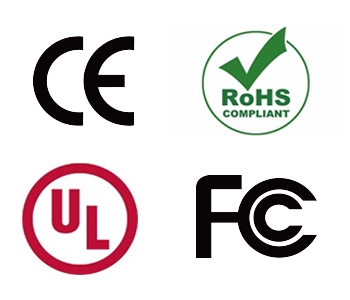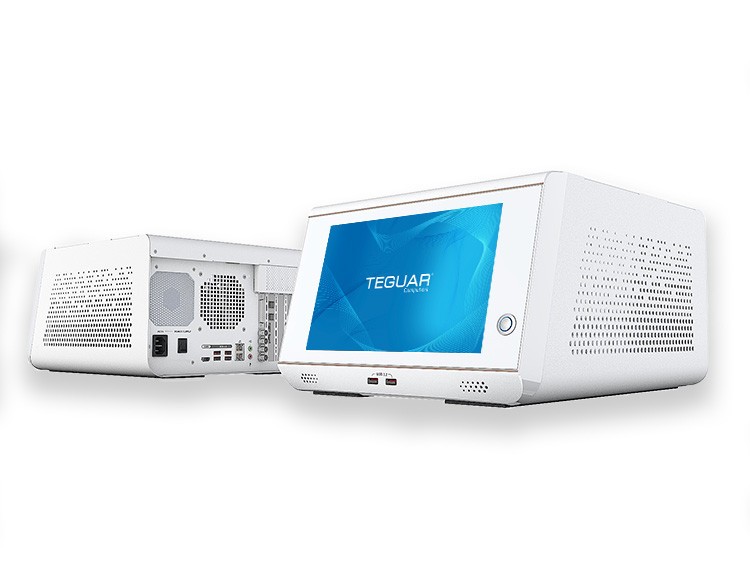Medical Computer Certifications Explained
 Medical devices and electronics are highly regulated to ensure patient safety. Each medical electrical device needs a specific set of certifications depending on the physical environment of the computer, the geographic location, and the application or way in which the computer/device will be used. The most common certifications are:
Medical devices and electronics are highly regulated to ensure patient safety. Each medical electrical device needs a specific set of certifications depending on the physical environment of the computer, the geographic location, and the application or way in which the computer/device will be used. The most common certifications are:
- IEC 60601
- UL 60601-1
- CE Mark
- RoHS
- FCC Compliance
It is a lot to navigate and can sometimes take years to gain certifications. The below is an overview of the standard certifications used in conjunction with medical computers. Many Teguar medical computers come with the certifications below. The degree of certification needed varies greatly per project.
What is IEC 60601?
IEC 60601 is the most widely used and recognized certification for medical equipment. IEC stands for International Electrotechnical Commission, which published the first version of IEC 60601 in 1977 and regularly updates it to keep up with the quickly changing healthcare IT landscape. IEC 60601 is separated into two parts: 60601-1 sets forth “general requirements for basic safety and essential performance” of medical electrical equipment, while 60601-2 identifies particular requirements.
The more crucial of the two parts is 60601-1. In fact, AAMI (Association for the Advancement of Medical Instrumentation) says, “It has come to be known throughout the industry as the ‘bible’ of medical electrical equipment standards.” The most recent revision to IEC 60601-1 is the 4th Edition, which was published in 2015.
IEC 60601-1 4th Edition is broken into the following parts:
| 60601-1-1 | Medical Electrical Systems |
| 60601-1-2 | Electromagnetic Compatibility |
| 60601-1-3 | Radiation Protection for Diagnostic X-Ray Systems |
| 60601-1-4 | Programmable Electrical Medical Systems |
| 60601-1-6 | Usability |
| 60601-1-8 | Medical Alarm Systems |
| 60601-1-9 | Environmentally Conscious Design |
| 60601-1-10 | Physiologic Closed Loop Controllers |
| 60601-1-11 | Home Healthcare Equipment |
| 60601-1-12 | Emergency Medical Environment |
While IEC is an internationally recognized standard, several countries have adopted their own version of the standard, some of which are exactly the same as IEC and others have slight changes. For example, “Clause 6 of the Canadian standard requires that safety instructions on equipment and in accompanying documents be written in both French and English.”
The naming of the standard varies by country:
| United States | UL 60601-1 |
| Canada | CAN/CSA C22.2 No. 60601-1 |
| European Union | EN 60601-1 |
| Israel | SI 60601 Part 1 |
| Japan | JIS T0601-1 |
| Australian and New Zealand | AS/NZ 3200.1.0 |
What is UL 60601-1?
 The U.S. national standard for testing electronic medical equipment is the “most detailed of all the national deviations to IEC 60601-1.” There are several unique requirements under UL, such as the requirement that polymeric materials be within a certain flammability threshold (i.e. resistant to burning). UL also uniquely “requires that x-ray equipment enclosures and associated equipment have a grounded enclosure around parts that are operating at over 600 V ac, 850 V dc, or 850 V peak.”
The U.S. national standard for testing electronic medical equipment is the “most detailed of all the national deviations to IEC 60601-1.” There are several unique requirements under UL, such as the requirement that polymeric materials be within a certain flammability threshold (i.e. resistant to burning). UL also uniquely “requires that x-ray equipment enclosures and associated equipment have a grounded enclosure around parts that are operating at over 600 V ac, 850 V dc, or 850 V peak.”
The U.S. standard is called “UL” because the organization that adapted IEC 60601-1 is Underwriters Laboratories Inc. (UL). UL is one of 20 Nationally Recognized Testing Laboratories (NRTL) by the Occupational Safety and Health Administration of US (OSHA). These laboratories comply with OSHA testing standards when certifying devices, equipment and materials used across several industries including healthcare.
What does a CE Mark mean?
The CE marking is used to verify the safety of products sold in the European Economic Area, however it is internationally recognized and used around the world. The letters “signify that products sold in the EEA have been assessed to meet high safety, health, and environmental protection requirements.”
For medical devices, the CE mark signifies that the device meets the safety and performance requirements set forth by the European Medical Device Directives.
How is a medical computer made RoHS compliant?
RoHS stands for Restriction of Hazardous Substances and it “restricts the use of specific hazardous materials found in electrical and electronic products.” Before 2011, medical electronic equipment needed to be compliant with both RoHS and CE, but now RoHS compliance is a requirement under CE. Therefore, devices produced after 2011 that bear CE mark are also RoHS compliant. RoHS 3 has taken effect on July 22, 2019 so keep this in mind when purchasing new products.
What is important to know about medical computer FCC compliance?
The Federal Communications Commission is a US agency that regulates “communications by radio, television, wire, satellite.” Most computers, smartphones and tablets must comply with the FCC to be sold in the US. Be sure your medical device meets the correct FCC class as there is FCC Class A built for business/industrial/commercial environments and FCC Class B for use in residential which is also about 10dB more restrictive on testing as they may be located near other sensitive electronics.
Sources:
“60601-1, 3rd Edition, Medical Electrical Equipment, Part 1.” 60601-1, 3rd Edition, Medical Electrical Equipment, Part 1 – Products – Association for the Advancement of Medical Instrumentation, Jan. 2012, www.aami.org/productspublications/ProductDetail.aspx?ItemNumber=1578.
“CE Marking.” Internal Market, Industry, Entrepreneurship and SMEs – European Commission, 30 Aug. 2017, ec.europa.eu/growth/single-market/ce-marking/.
“Collateral Standards for IEC 60601-1.” MDDI Online, 7 Aug. 2017, www.mddionline.com/collateral-standards-iec-60601-1.
“IEC System of Conformity Assessment Schemes.” IEC Standard GD and ND, www.iecee.org/dyn/www/f?p=106%3A56%3A0%3A%3A%3A%3AFSP_STD_ID%3A2606.
“National Deviations to IEC 60601-1.” MDDI Online, 6 Sept. 2017, www.mddionline.com/national-deviations-iec-60601-1.
“UNITED STATES DEPARTMENT OF LABOR.” Nationally Recognized Testing Laboratories (NRTLs) | Current List of NRTLs | Occupational Safety and Health Administration, www.osha.gov/dts/otpca/nrtl/nrtllist.html.
“What We Do.” Federal Communications Commission, 10 July 2017, www.fcc.gov/about-fcc/what-we-do.
“RoHS Guide.” RoHS Compliance FAQ, Dec. 2019, www.rohsguide.com/rohs-faq.htm.
Previous Article
Selecting an Industrial Computer for Your Manufacturing Environment











